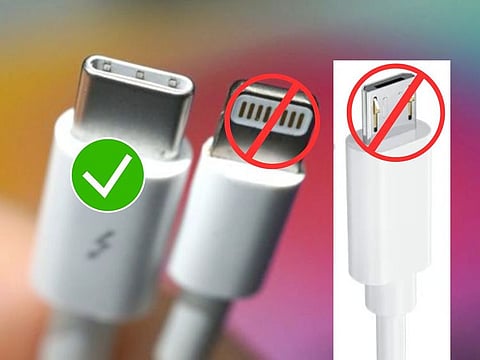Only USB-C charging allowed: Is it good for you?
EU law mandating USB-C compatibility for certain electronic devices to kick in from 2024

Highlights
- Manufacturers would need to comply with the USB-C law by incorporating USB-C ports in their devices.
- The new mandate, which covers 27 EU countries, could simplify the charging process.
- Short-term disruptions expected by move could reduce the need for carrying multiple chargers or adapters.
A new law mandating the adoption of USB-C as the standard charging cable in Europe has potential implications for end-users across the world.
The move, agreed upon by all 27 EU-member countries, could lead to standardisation of charging ports not just in the eurozone, but across the planet.
What happened?
The so-called "common charger directive", which makes USB-C the standard charging cord throughout the EU, was accepted by members of the European Council in October 2022.
Following publication in the Official Journal of the European Union, it will make it effective in 24 months — it kicks in from 2024.
What does the mandate cover?
USB-C will be the standard charging plug from 2024 for the following:
What about laptops?
The EU mandate requires laptops to use the USB-C cable in 2026.
What happens to device makers?
They have to abide by the mandate if they want to sell products within the EU, i.e. adopt USB-C as a universal charging standard.
What does this mean for users?
As an end-user, you can charge your devices — phone, video game controllers, laptops, tablets, and more — with a single USB-C cord, regardless of the brand or model.
Currently, there are a number of de-facto standards for charging ports in mobile devices — USB-A, micro-USB, USB-C and Lightning. Standardising on one (USB-C) could be good for consumers, though it could lead to certain short-term transition challenges.
Would it mean the standardisation of phone chargers?
For the EU zone, it would — from 2024 itself. Now, all devices makers, including Apple, must equip new models only with USB-C charging ports, or they won't be allowed to be legally sold in the EU.
For other regions where no specific charging cable format is mandated, standardisation could take time.
In terms of manufacturing, however, it would be more cost-effective and efficient to have one charging port for all products sold across all regions of the world.
USB-C vs USB-A vs Lightning cable
• USB-A could only support up to 2.5 watts and 5 volts. • USB-C is more flexible as it now supports 100 watts and 20 volts easily enough for larger devices. • “Lightning” cable formats mostly support or are only meant to work with Apple devices.
What did manufacturers say?
Most are expected to abide by the new rule. Some mobile phone, tablet and headphone makers, however, say it may stifle charging innovation.
Why was the law passed?
The common charger directive took 10 years to craft and is designed to reduce the amount of electronic waste.
Standard charging for smartphone
Standard charging for smartphones range from 18-150W, while tablets go up to 45W. The latest laptops may even offer 240W charging over USB-C. Most phones/laptops already use USB-C for charging.
Fast charger for mobile phones
Most phones and other devices are capable of handling 5V/2.4A. For fast charging, manufacturers raise the voltage up from 5V to 9V or 12V and beyond — or raise amperage to 3A and above.
The introduction of USB-C helps accomplish this with support for up to 100W and 20V, which makes faster charging speeds possible.
What are the implications of this move?
USB-C is recognised as versatile connector that supports fast data transfer rates and higher power delivery compared to older USB standards. Among the expected benefits of the EU's move include
Standardisation of charging ports:
The EU law mandating the use of USB-C as a universal charging port for specific devices would lead to greater standardisation across devices.
Convenience and interoperability:
Users would benefit from faster charging speeds, improved data transfer rates, and the ability to connect various peripherals and accessories using a single USB-C cable. This would enhance convenience and interoperability between different devices.
Increased availability of USB-C accessories:
With a widespread adoption of USB-C, the availability and variety of USB-C cables, chargers, and adapters would likely increase. Users would have a wider range of options to choose from, and they would not have to rely solely on the accessories provided by the device manufacturer. This could lead to increased competition and potentially lower prices for USB-C accessories.
Transition challenges
This law could pose some challenges during the transition period. Existing devices with different charging ports, such as Micro USB or Lightning, may not be directly compatible with USB-C cables — which means you would need to purchase new cables or adapters to ensure compatibility. However, this inconvenience is temporary and should be mitigated as USB-C becomes the standard across devices.
Impact on device design:
As manufacturers comply and incorporate USB-C ports in their devices, this could impact the design of devices, especially those that currently use proprietary charging ports. Some manufacturers need to modify their product designs or develop adapters to maintain compatibility with existing accessories.
Sign up for the Daily Briefing
Get the latest news and updates straight to your inbox



